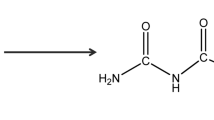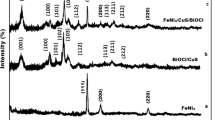Abstract
The author presents an efficient method for the synthesis of copper nanocomposites (CuNC) using human urine. The role of human urine on the decomposition of copper nitrate was investigated. X-ray diffraction (XRD) results indicate the presence of compounds of calcium copper oxide (CaCuO2), calcium carbonate (CaCO3), copper (I) sulphide (Cu2S), and sodium copper oxide (NaCuO) in the sample. The energy-dispersive X-ray spectroscopy (EDS) results show that the elements copper (Cu), oxygen (O), and sulphur (S) have their own peaks. Calcium (Ca) and nitrogen (N) also have secondary peaks. Field-emission scanning electron microscope (FESEM) results show non-uniform structures like clusters of nanoparticles (NPs) with different nanodiameters. The optical analysis shows a clear absorption peak at 325 nm with a direct optical energy gap of 2.85 eV, hence being similar to the manner in which copper oxides behave. The antibacterial activity results confirm that CuNC has a high inhibitory effect against Streptococcus pyogenes and Proteus mirabilis. The maximum zone of inhibition against Proteus mirabilis is 22 mm, and against Streptococcus pyogenes is 26 mm. The current work is complementary to previous work in the field of employing the effect of human urine in the synthesis of NPs or NCs.







Similar content being viewed by others
Availability of Data and Material
Not applicable.
References
Jabir MS, Nayef UM, Abdul KWK (2019) Polyethylene glycol-functionalized magnetic (Fe3O4) nanoparticles: a novel DNA-mediated antibacterial agent. Nano Biomed Eng 11(1):18–27
Naz S, Gul A, Zia M, Javed R (2023) Synthesis, biomedical applications, and toxicity of CuO nanoparticles. Appl Microbiol Biotechnol 107(4):1039–1061
Khashan KS, Sulaiman GM, Hussain SA, Marzoog TR, Jabir MS (2020) Synthesis, characterization and evaluation of anti-bacterial, anti-parasitic and anti-cancer activities of aluminum-doped zinc oxide nanoparticles. J Inorg Organomet Polym Mater 30(9):3677–3693
Schlesinger ME, Sole KC, Davenport WG, Alvear GR (2021) Extractive metallurgy of copper. Elsevier
Tamilvanan A, Balamurugan K, Ponappa K, Kumar BM (2014) Copper nanoparticles: synthetic strategies, properties and multifunctional application. Int J Nanosci 13(02):1430001
Markin AV, Markina NE (2019) Experimenting with plasmonic copper nanoparticles to demonstrate color changes and reactivity at the nanoscale. J Chem Educ 96(7):1438–1442
Mohanpuria P, Rana NK, Yadav SK (2008) Biosynthesis of nanoparticles: technological concepts and future applications. J Nanopart Res 10:507–517
Antonijevic M, Petrovic M (2008) Copper corrosion inhibitors. A review. Int J Electrochem Sci 3(1):1–28
Rubilar O, Rai M, Tortella G, Diez MC, Seabra AB, Durán N (2013) Biogenic nanoparticles: copper, copper oxides, copper sulphides, complex copper nanostructures and their applications. Biotech Lett 35:1365–1375
Knauth P, Schoonman J (2006) Nanostructured materials: selected synthesis methods, properties and applications. Springer Science & Business Media
Crisan MC, Teodora M, Lucian M (2021) Copper nanoparticles: synthesis and characterization, physiology, toxicity and antimicrobial applications. Appl Sci 12(1):141
Liu Y, Liu M, Swihart MT (2017) Plasmonic copper sulfide-based materials: a brief introduction to their synthesis, doping, alloying, and applications. J Phys Chem C 121(25):13435–13447
Li G, Li X, Zhang Z (2011) Preparation methods of copper nanomaterials. Progress Chem 23(8):1644
Liu J, Qiao SZ, Hu QH, Lu GQ (2011) Magnetic nanocomposites with mesoporous structures: synthesis and applications. Small 7(4):425–443
Abd-Elkader OH, Deraz N (2013) Synthesis and characterization of new copper based nanocomposite. Int J Electrochem Sci 8:8614–8622
Tonelli D, Scavetta E, Gualandi I (2019) Electrochemical deposition of nanomaterials for electrochemical sensing. Sensors 19(5):1186
Mohammed SA, Khashan KS, Jabir MS, Abdulameer FA, Sulaiman GM, Al-Omar MS, Mohammed HA, Hadi AA, Khan RA (2022) Copper oxide nanoparticle-decorated carbon nanoparticle composite colloidal preparation through laser ablation for antimicrobial and antiproliferative actions against breast cancer cell line, MCF-7. BioMed Res Int 2022:1–13
Wu Y, Han S, Li Y, Shen W (2022) Fabrication of monodisperse gold-copper nanocubes and AuCu-cuprous sulfide heterodimers by a step-wise polyol reduction. J Colloid Interface Sci 626:136–145
Rahmah MI (2021) Preparation of silver chloride nanoparticles using human urine. Appl Nanosci 11(10):2611–2615
Sarigul N, Korkmaz F, Kurultak İ (2019) A new artificial urine protocol to better imitate human urine. Sci Rep 9(1):20159
Kirchmann H, Pettersson S (1994) Human urine-chemical composition and fertilizer use efficiency. Fertil Res 40:149–154
Viskari E-L, Grobler G, Karimäki K, Gorbatova A, Vilpas R, Lehtoranta S (2018) Nitrogen recovery with source separation of human urine—preliminary results of its fertiliser potential and use in agriculture. Front Sustain Food Syst 2:32
Bahjat HH, Ismail RA, Sulaiman GM, Jabir MS (2021) Magnetic field-assisted laser ablation of titanium dioxide nanoparticles in water for anti-bacterial applications. J Inorg Organomet Polym Mater 31:3649–3656
Mohammed MK, Mohammad M, Jabir MS, Ahmed D (2020) Functionalization, characterization, and antibacterial activity of single wall and multi wall carbon nanotubes. IOP Conf Ser: Mater Sci Eng 757:012028
Sabry RS, Al-Haidarie YK, Kudhier MA (2016) Synthesis and photocatalytic activity of TiO 2 nanoparticles prepared by sol–gel method. J Sol-Gel Sci Technol 78:299–306
John KI, Adenle AA, Adeleye AT, Onyia IP, Amune-Matthews C, Omorogie MO (2021) Unravelling the effect of crystal dislocation density and microstrain of titanium dioxide nanoparticles on tetracycline removal performance. Chem Phys Lett 776:138725
Kireev P (1978) Semiconductor physics. MIR Publishers, Moscow
Zhang Y, Wang W, Yao H (2022) Urea-based nitrogen fertilization in agriculture: a key source of N2O emissions and recent development in mitigating strategies. Arch Agron Soil Sci 14:1–16
Ma C, Ban T, Yu H, Li Q, Li X, Jiang W, Xie J (2019) Urea addition promotes the metabolism and utilization of nitrogen in cucumber. Agronomy 9(5):262
Yu Y, Zhang L, Wang J, Yang Z, Long M, Hu N, Zhang Y (2012) Preparation of hollow porous Cu2O microspheres and photocatalytic activity under visible light irradiation. Nanoscale Res Lett 7(1):1–6
Khan J, Siddiq M, Akram B, Ashraf MA (2018) In-situ synthesis of CuO nanoparticles in P (NIPAM-co-AAA) microgel, structural characterization, catalytic and biological applications. Arab J Chem 11(6):897–909
Logpriya S, Bhuvaneshwari V, Vaidehi D, SenthilKumar R, Nithya Malar R, Pavithra Sheetal B, Amsaveni R, Kalaiselvi M (2018) Preparation and characterization of ascorbic acid-mediated chitosan–copper oxide nanocomposite for anti-microbial, sporicidal and biofilm-inhibitory activity. J Nanostruct Chem 8(3):301–309
Hidayat T, Dewi R, Hamzah Y (2021) Effect of holding time on optical structure properties of Ba (Zr0.5Ti0.5) O3 thin film using sol–gel method. Sci, Technol Commun J 1(2):59–66
Bilal A, Kasi JK, Kasi AK, Bokhari M, Ahmed S, Ali SW (2022) Environment friendly synthesis of nickel ferrite nanoparticles using Brassica oleracea var capitate (green cabbage) as a fuel and their structural and magnetic characterizations. Mater Chem Phys 290:126483
Wang Z, Li N, Zhao J, White JC, Qu P, Xing B (2012) CuO nanoparticle interaction with human epithelial cells: cellular uptake, location, export, and genotoxicity. Chem Res Toxicol 25(7):1512–1521
Jose GP, Santra S, Mandal SK, Sengupta TK (2011) Singlet oxygen mediated DNA degradation by copper nanoparticles: potential towards cytotoxic effect on cancer cells. J Nanobiotechnol 9:1–8
Cheloni G, Marti E, Slaveykova VI (2016) Interactive effects of copper oxide nanoparticles and light to green alga Chlamydomonas reinhardtii. Aquat Toxicol 170:120–128
Wang Z, Zhang Y, Qu X, Chen F, Zhao X (2023) Self-assembled nanostructure of copper hydrogen phosphate with catalytic and antibacterial activity. Ceram Int 49:20168–20173
Tejeda C, Villegas M, Steuer P, Iranzo EC, González N, Ramirez-Reveco A, Salgado M (2022) Understanding the antibacterial mechanisms of copper ion treatment on Mycobacterium avium subsp paratuberculosis. Vet Microbiol 268:109412
Phan D-N, Dorjjugder N, Saito Y, Khan MQ, Ullah A, Bie X, Taguchi G, Kim I-S (2020) Antibacterial mechanisms of various copper species incorporated in polymeric nanofibers against bacteria. Mater Today Commun 25:101377
Funding
This work was funded by Al-Karkh University of Science.
Author information
Authors and Affiliations
Corresponding author
Ethics declarations
Conflict of Interest
No potential competing interests was reported by the author.
Ethical Approval
Not applicable.
Consent for Publication
Not applicable.
Rights and permissions
Springer Nature or its licensor (e.g. a society or other partner) holds exclusive rights to this article under a publishing agreement with the author(s) or other rightsholder(s); author self-archiving of the accepted manuscript version of this article is solely governed by the terms of such publishing agreement and applicable law.
About this article
Cite this article
Rahmah, M.I. Synthesize of Copper Nanocomposite Mediated Human Urine: Estimated of their Antibacterial Activity. Chemistry Africa (2024). https://doi.org/10.1007/s42250-024-00912-7
Received:
Accepted:
Published:
DOI: https://doi.org/10.1007/s42250-024-00912-7




